Comparison between MODFLOW Groundwater Modeling with Traditional and Distributed Recharge
Abstract
1. Introduction
2. Materials and Methods
3. Study Area
4. Results and Discussion
5. Conclusions
Author Contributions
Funding
Data Availability Statement
Acknowledgments
Conflicts of Interest
References
- Uchenna, U.P.; Lancia, M.; Viaroli, S.; Ugbaja, A.N.; Galluzzi, M.; Zheng, C. Groundwater Sustainability in African Metropolises: Case Study from Calabar, Nigeria. J. Hydrol. Reg. Stud. 2023, 45, 101314. [Google Scholar] [CrossRef]
- Cook, P.G.; Shanafield, M.; Andersen, M.S.; Bourke, S.; Cartwright, I.; Cleverly, J.; Currell, M.; Doody, T.M.; Hofmann, H.; Hugmann, R.; et al. Sustainable Management of Groundwater Extraction: An Australian Perspective on Current Challenges. J. Hydrol. Reg. Stud. 2022, 44, 101262. [Google Scholar] [CrossRef]
- Fotovat, M.; Porhemmat, J.; Sedghi, H.; Babazadeh, H. Evaluation of Weap-Modflow Model as an Integrated Water Resources Management Model for Sustainable Development (a Case Study: Gharesoo at Doab-Merek, Kermanshah, Iran). Civ. Eng. Infrastruct. J. 2019, 52, 167–183. [Google Scholar] [CrossRef]
- Alsevavni, I.N.; Almohseen, K.A. Integrated Application of (Modflow) and (Weap) Model in Nineveh Province. J. Univ. Duhok 2017, 20, 680–690. [Google Scholar] [CrossRef]
- Khadri, S.F.R.; Pande, C. Groundwater Flow Modeling for Calibrating Steady State Using MODFLOW Software: A Case Study of Mahesh River Basin, India. Model. Earth Syst. Environ. 2016, 2, 39. [Google Scholar] [CrossRef]
- Chen, M.; Izady, A.; Abdalla, O.A. An Efficient Surrogate-Based Simulation-Optimization Method for Calibrating a Regional MODFLOW Model. J. Hydrol. 2017, 544, 591–603. [Google Scholar] [CrossRef]
- Ochoa-González, G.H.; Carreón-Freyre, D.; Cerca, M.; López-Martínez, M. Assessment of Groundwater Flow in Volcanic Faulted Areas. A Study Case in Queretaro, Mexico. Geofís. Int. 2015, 54, 199–220. [Google Scholar] [CrossRef]
- Peñuela Arévalo, L.A.; Carrillo Rivera, J.J. Definición de Zonas de Recarga y Descarga de Agua Subterránea a Partir de Indicadores Superficiales: Centro—Sur de La Mesa Central, México. Investig. Geogr. 2013, 81, 18–32. [Google Scholar] [CrossRef][Green Version]
- Sánchez-San Román, J. Hidrología Superficial y Subterránea, 1st ed.; Universidad de Salamanca: Salamanca, Spain, 2017. [Google Scholar]
- El Moneam, M.A. Review of Artificial Recharge Prospects for Augmentation of Groundwater in Egypt: A Case Study of El Bustan Extension Area. Ain Shams Eng. J. 2023, 14, 101995. [Google Scholar] [CrossRef]
- Hughes, J.D.; Russcher, M.J.; Langevin, C.D.; Morway, E.D.; McDonald, R.R. The MODFLOW Application Programming Interface for Simulation Control and Software Interoperability. Environ. Model. Softw. 2022, 148, 105257. [Google Scholar] [CrossRef]
- Jafari, T.; Kiem, A.S.; Javadi, S.; Nakamura, T.; Nishida, K. Fully Integrated Numerical Simulation of Surface Water-Groundwater Interactions Using SWAT-MODFLOW with an Improved Calibration Tool. J. Hydrol. Reg. Stud. 2021, 35, 100822. [Google Scholar] [CrossRef]
- Siddik, M.S.; Tulip, S.S.; Rahman, A.; Islam, M.N.; Haghighi, A.T.; Mustafa, S.M.T. The Impact of Land Use and Land Cover Change on Groundwater Recharge in Northwestern Bangladesh. J. Environ. Manag. 2022, 315, 115130. [Google Scholar] [CrossRef] [PubMed]
- Hartmann, A.; Gleeson, T.; Wada, Y.; Wagener, T. Enhanced Groundwater Recharge Rates and Altered Recharge Sensitivity to Climate Variability through Subsurface Heterogeneity. Proc. Natl. Acad. Sci. USA 2017, 114, 2842–2847. [Google Scholar] [CrossRef]
- Ayvaz, M.T.; Elçi, A. Groundwater Recharge Rate and Zone Structure Estimation Using PSOLVER Algorithm. Groundwater 2014, 52, 434–447. [Google Scholar] [CrossRef]
- Ke, T.; Shu, L.; Chen, X. Modeling the Groundwater Recharge in Karst Aquifers by Using a Reservoir Model. Water Sci. Technol. 2013, 68, 406–412. [Google Scholar] [CrossRef] [PubMed]
- Guerrero-Morales, J.; Fonseca, C.R.; Goméz-Albores, M.A.; Sampedro-Rosas, M.L.; Silva-Gómez, S.E. Proportional Variation of Potential Groundwater Recharge as a Result of Climate Change and Land-Use: A Study Case in Mexico. Land 2020, 9, 364. [Google Scholar] [CrossRef]
- Ahuanlla Huaccha, J.L.; Díaz Aguilar, R.D.; Vigo Rivera, J.E.; Callate Chura, R.A. Aplicación de Modflow 6 Con Model Mouse 4 Para El Modelamiento Del Flujo Subterráneo de La Microcuenca Macarí, Melgar—Perú. Rev. Investig. Cienc. Tecnol. Desarro. 2022, 7, 1–11. [Google Scholar] [CrossRef]
- Abbas, S.A.; Xuan, Y.; Bailey, R.T. Assessing Climate Change Impact on Water Resources in Water Demand Scenarios Using SWAT-MODFLOW-WEAP. Hydrology 2022, 9, 164. [Google Scholar] [CrossRef]
- Loukika, K.N.; Venkata Reddy, K.; Durga Rao, K.H.V.; Singh, A. Estimation of Groundwater Recharge Rate Using SWAT MODFLOW Model. In Applications of Geomatics in Civil Engineering, Proceedings of the ICGCE 2018, Phuket, Thailand, 10–12 January 2018; Springer: Singapore, 2020; pp. 143–154. [Google Scholar]
- Ware, H.H.; Mengistu, T.D.; Yifru, B.A.; Chang, S.W.; Chung, I.-M. Assessment of Spatiotemporal Groundwater Recharge Distribution Using SWAT-MODFLOW Model and Transient Water Table Fluctuation Method. Water 2023, 15, 2112. [Google Scholar] [CrossRef]
- Szymkiewicz, A.; Gumuła-Kawęcka, A.; Šimůnek, J.; Leterme, B.; Beegum, S.; Jaworska-Szulc, B.; Pruszkowska-Caceres, M.; Gorczewska-Langner, W.; Angulo-Jaramillo, R.; Jacques, D. Simulations of Freshwater Lens Recharge and Salt/Freshwater Interfaces Using the HYDRUS and SWI2 Packages for MODFLOW. J. Hydrol. Hydromech. 2018, 66, 246–256. [Google Scholar] [CrossRef]
- Noori, R.; Maghrebi, M.; Jessen, S.; Bateni, S.M.; Heggy, E.; Javadi, S.; Noury, M.; Pistre, S.; Abolfathi, S.; AghaKouchak, A. Decline in Iran’s Groundwater Recharge. Nat. Commun. 2023, 14, 6674. [Google Scholar] [CrossRef]
- Sallwey, J.; Bonilla Valverde, J.P.; Vásquez López, F.; Junghanns, R.; Stefan, C. Suitability Maps for Managed Aquifer Recharge: A Review of Multi-Criteria Decision Analysis Studies. Environ. Rev. 2019, 27, 138–150. [Google Scholar] [CrossRef]
- Niswonger, R.G.; Morway, E.D.; Triana, E.; Huntington, J.L. Managed Aquifer Recharge through Off-season Irrigation in Agricultural Regions. Water Resour. Res. 2017, 53, 6970–6992. [Google Scholar] [CrossRef]
- Russo, T.A.; Fisher, A.T.; Lockwood, B.S. Assessment of Managed Aquifer Recharge Site Suitability Using a GIS and Modeling. Groundwater 2015, 53, 389–400. [Google Scholar] [CrossRef]
- Maples, S.R.; Fogg, G.E.; Maxwell, R.M. Modeling Managed Aquifer Recharge Processes in a Highly Heterogeneous, Semi-Confined Aquifer System. Hydrogeol. J. 2019, 27, 2869–2888. [Google Scholar] [CrossRef]
- López, B.; Rosales, L.; Saavedra, O. Modelación Hidrogeológica en el Valle Central de Cochabamba-Bolivia. Investig. Desarro. 2023, 23, 23–39. [Google Scholar] [CrossRef]
- Dar, T.; Rai, N.; Bhat, A. Delineation of Potential Groundwater Recharge Zones Using Analytical Hierarchy Process (AHP). Geol. Ecol. Landsc. 2021, 5, 292–307. [Google Scholar] [CrossRef]
- Vasileva, T. An Assessment of Potential Groundwater Recharge Zones in Bulgaria. Geol. Balc. 2019, 48, 43–61. [Google Scholar] [CrossRef]
- Andreo, B.; Vías, J.; López-Greta, J.A.; Carrasco, F.; Durán, J.J.; Jiménez, P. Propuesta Metodológica Para La Estimación de La Recarga En Acuíferos Carbonáticos. Bol. Geol. Min. 2004, 115, 177–186. [Google Scholar]
- Lara-Vásconez, N.X.; Cushquicullma-Colcha, D.F.; Guaiña-Yungán, J.I.; Espinoza, V.M.; Ati-Cutiupala, G.M. Identificación de Zonas Potenciales de Recarga y Descarga de Agua Subterránea En La Subcuenca Del Río Chambo Mediante Los Sistemas de Información Geográfica y El Análisis Multicriterio. Rev. Cient.-Acad. Multidiscip. 2021, 6, 122–148. [Google Scholar]
- Boyás Martínez, E.; Cervantes Victoria, G.I.; González Mora, M.F. Determinación de Sitios Potenciales de Recarga Artificial de Agua Subterránea EN LOS Acuíferos Que Conforman La Subregión Valle de México; Centro de Investigación en Ciencias de Información Geoespacial: México City, Mexico, 2020. [Google Scholar]
- Hernández-Juárez, R.A.; Martinez Rivera, L.M.; Peñuela-Arévalo, L.A.; Rivera-Reyes, S. Identificación de Zonas Potenciales de Recarga y Descarga de Agua Subterránea En La Cuenca Del Río Ayuquila-Armería Mediante El Uso de SIG y El Análisis Multicriterio. Investig. Geogr. 2020. [Google Scholar] [CrossRef]
- Singh, S.K.; Zeddies, M.; Shankar, U.; Griffiths, G.A. Potential Groundwater Recharge Zones within New Zealand. Geosci. Front. 2019, 10, 1065–1072. [Google Scholar] [CrossRef]
- Ardakani, A.H.H.; Shojaei, S.; Shahvaran, A.R.; Kalantari, Z.; Cerdà, A.; Tiefenbacher, J. Selecting Potential Locations for Groundwater Recharge by Means of Remote Sensing and GIS and Weighting Based on Boolean Logic and Analytic Hierarchy Process. Environ. Earth Sci. 2022, 81, 8. [Google Scholar] [CrossRef]
- Matus Silva, O.D. Elaboración Participativa de Una Metodología Para La Identificación de Zonas Potenciales de Recarga Hídrica En Subcuencas Hidrográficas, Aplicada a La Subcuenca Del Río Jucuapa, Matagalpa, Nicaragua. Master’s Thesis, CATIE, Turrialba, Costa Rica, 2007. [Google Scholar]
- Mussa, K.R.; Mjemah, I.C.; Machunda, R.L. Open-Source Software Application for Hydrogeological Delineation of Potential Groundwater Recharge Zones in the Singida Semi-Arid, Fractured Aquifer, Central Tanzania. Hydrology 2020, 7, 28. [Google Scholar] [CrossRef]
- Agarwal, R.; Garg, P.K. Remote Sensing and GIS Based Groundwater Potential Recharge Zones Mapping Using Multi-Criteria Decision-Making Technique. Water Resour. Manag. 2016, 30, 243–260. [Google Scholar] [CrossRef]
- Harbaugh, A.W. MODFLOW-2005: The U.S. Geological Survey Modular Ground-Water Model—The Ground-Water Flow Process; US Department of the Interior, US Geological Survey: Reston, VA, USA, 2005. [Google Scholar]
- Chiang, W.-H. 3D-Groundwater Modeling with PMWIN, 2nd ed.; Springer: New York, NY, USA, 2005; ISBN 103-540-27590-8. [Google Scholar]
- Bagherzadeh, S.; Nobandegani, A.F.; Rahimi, Z.; Derakhshan, Z.; Rajabi, S.; Shirgahi, F.; Mohammadpour, A. Predicting the Alleviation of Nitrate Contamination in Aquifers by Conducting Management Scenarios Using the PMWIN Software: Application in the Andimeshk Plain, Iran. Groundw. Sustain. Dev. 2023, 20, 100883. [Google Scholar] [CrossRef]
- Talebi, S.; Rakhshandehro, G.; ParsiMehr, M.; Rezaei, S. Simulating Quar-Maharlu Aquifer in Fars Province, Iran, and Optimizing Artificial Recharge Using PMWIN Model. J. Adv. Environ. Health Res. 2022, 10, 105–118. [Google Scholar] [CrossRef]
- Stockholm Environment Institute. Guía Metodológica. Modelación Hidrológica y de Recursos Hídricos Con El Modelo WEAP; Centro de Cambio Global-Universidad Católica de Chile, Stockholm Environment Institute: Santiago, Chile, 2009. [Google Scholar]
- CONABIO. Portal de Geoinformación. 2022. Available online: http://www.conabio.gob.mx/informacion/gis/ (accessed on 19 February 2023).
- INEGI. Continuo de Elevaciones Mexicano (CEM). Available online: https://www.inegi.org.mx/app/geo2/elevacionesmex/ (accessed on 22 August 2023).
- Arellano-Lara, F.; Escalante-Sandoval, C.A. Multivariate Delineation of Rainfall Homogeneous Regions for Estimating Quantiles of Maximum Daily Rainfall: A Case Study of Northwestern Mexico. Atmosfera 2014, 27, 47–60. [Google Scholar] [CrossRef]
- CICESE. Base de Datos Climatológica Nacional (Sistema CLICOM). Available online: http://clicom-mex.cicese.mx/mapa.html (accessed on 19 February 2023).
- CONAGUA. Aguas Subterráneas. Available online: https://sigagis.conagua.gob.mx/gas1/sections/Disponibilidad_Acuiferos.html (accessed on 22 August 2023).
- Smith, L.; Wheatcraft, S.W. Handbook of Hydrology; Maidment, D.R., Ed.; McGraw-Hill: New York, NY, USA, 1993; Chapter 6. [Google Scholar]
- Villanueva Martínez, M.; Iglesias López, A. Pozos y Acuíferos. Técnicas de Evaluación Mediante Ensayos de Bombeo; Instituto Geológico y Minero de España: Madrid, Spain, 1984; ISBN 84-7474-258-7. [Google Scholar]
- Servicio Geológico Mexicano. GeoInfoMEx. Available online: https://www.sgm.gob.mx/GeoInfoMexGobMx/# (accessed on 14 September 2023).
- CONAGUA. Base de Datos Del REPDA. Available online: https://app.conagua.gob.mx/consultarepda.aspx (accessed on 22 August 2023).
- Chen, F.-W.; Liu, C.-W. Estimation of the Spatial Rainfall Distribution Using Inverse Distance Weighting (IDW) in the Middle of Taiwan. Paddy Water Environ. 2012, 10, 209–222. [Google Scholar] [CrossRef]
- Gobierno de México Data México Morelia. Available online: https://www.economia.gob.mx/datamexico/es/profile/geo/morelia (accessed on 22 August 2023).
- CONAGUA. Gerencia de Planificación Hídrica; Sistema Nacional de Información del Agua Numeragua 2022; CONAGUA: Mexico City, Mexico, 2022. [Google Scholar]
- Fox, D.M.; Bryan, R.B.; Price, A.G. The Influence of Slope Angle on Final Infiltration Rate for Interrill Conditions. Geoderma 1997, 80, 181–194. [Google Scholar] [CrossRef]
- Sharma, K.D.; Singh, H.P.; Pareek, O.P. Rainwater Infiltration into a Bare Loamy Sand. Hydrol. Sci. J. 1983, 28, 417–424. [Google Scholar] [CrossRef]
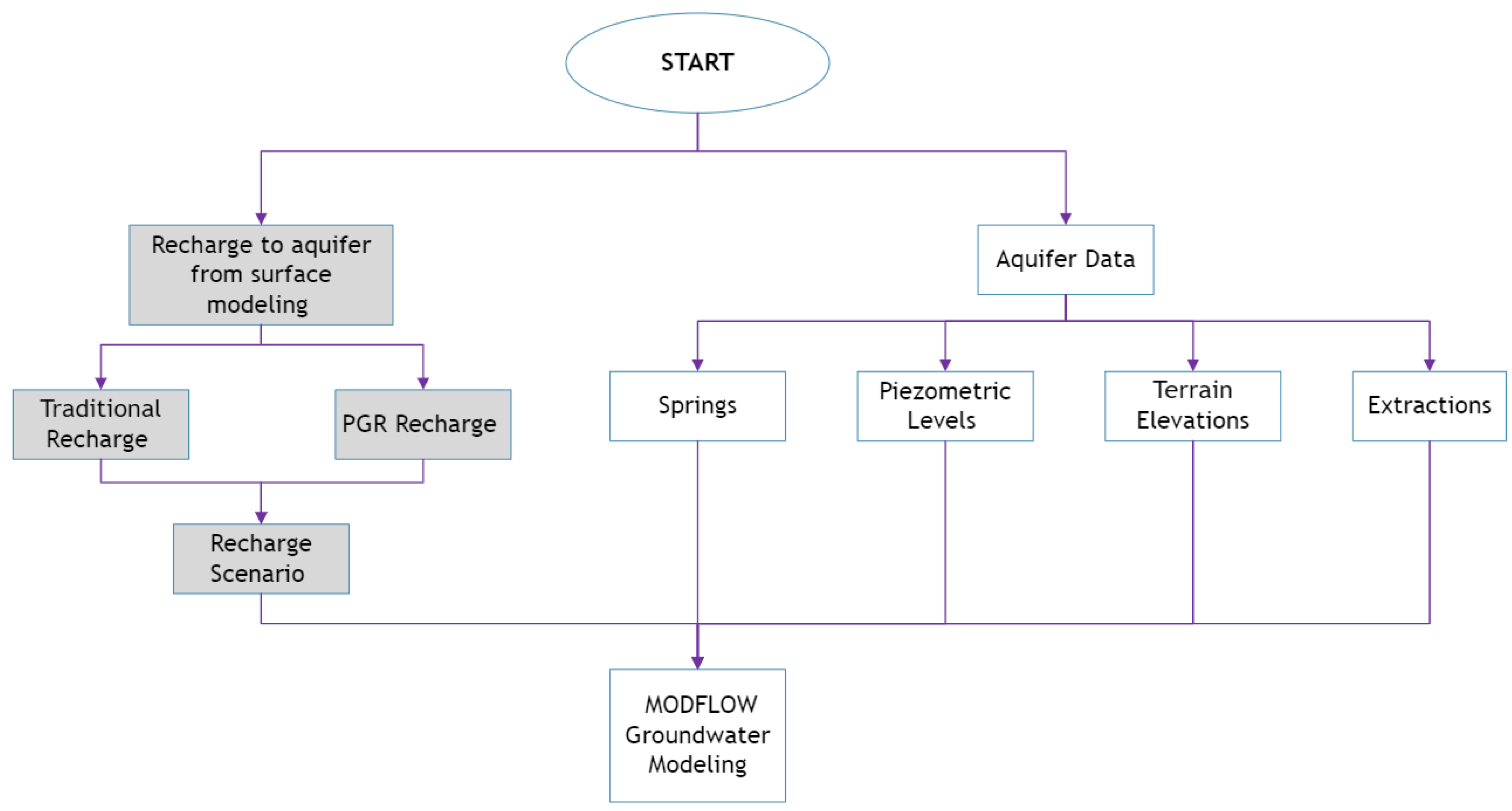
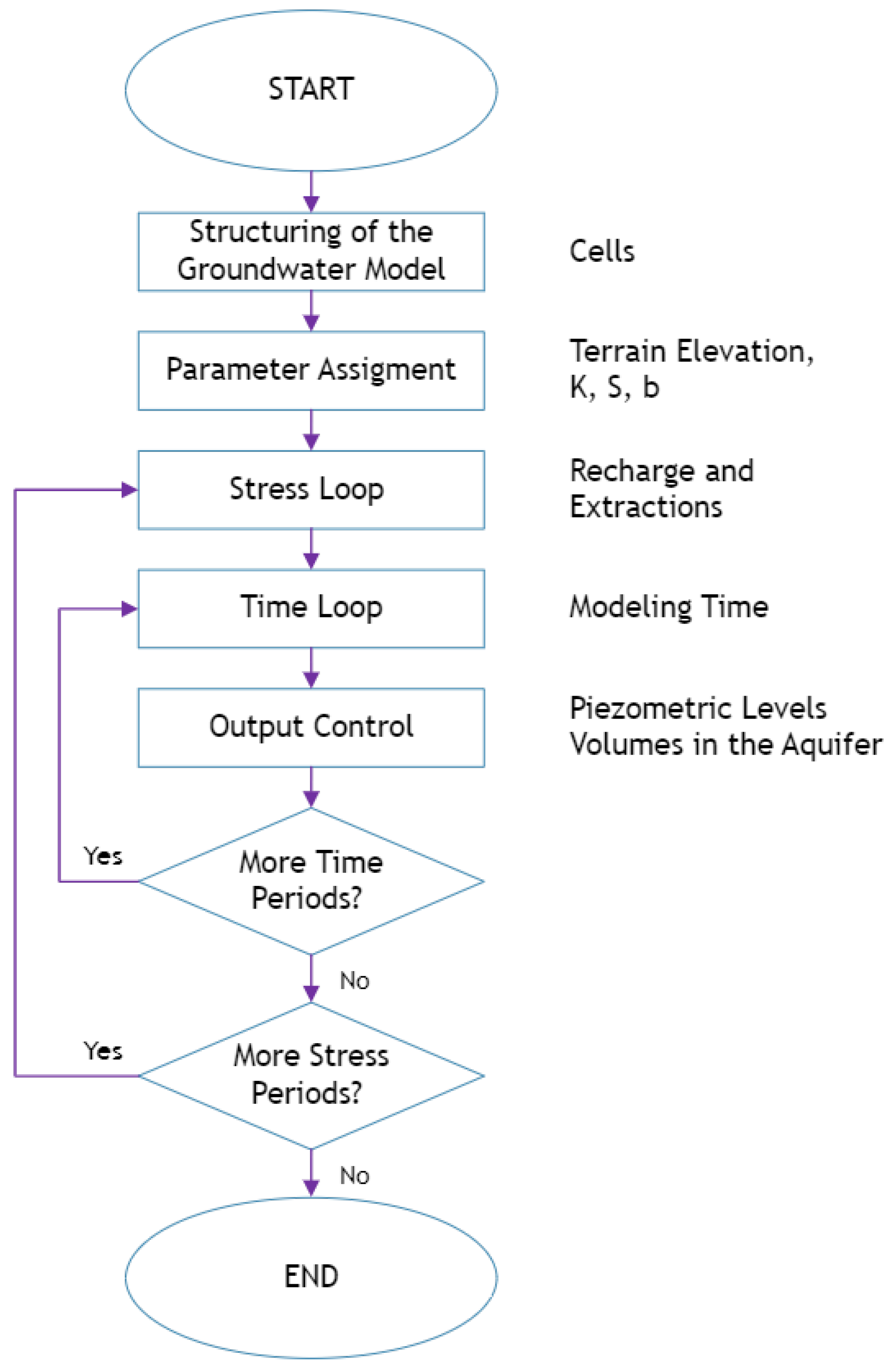

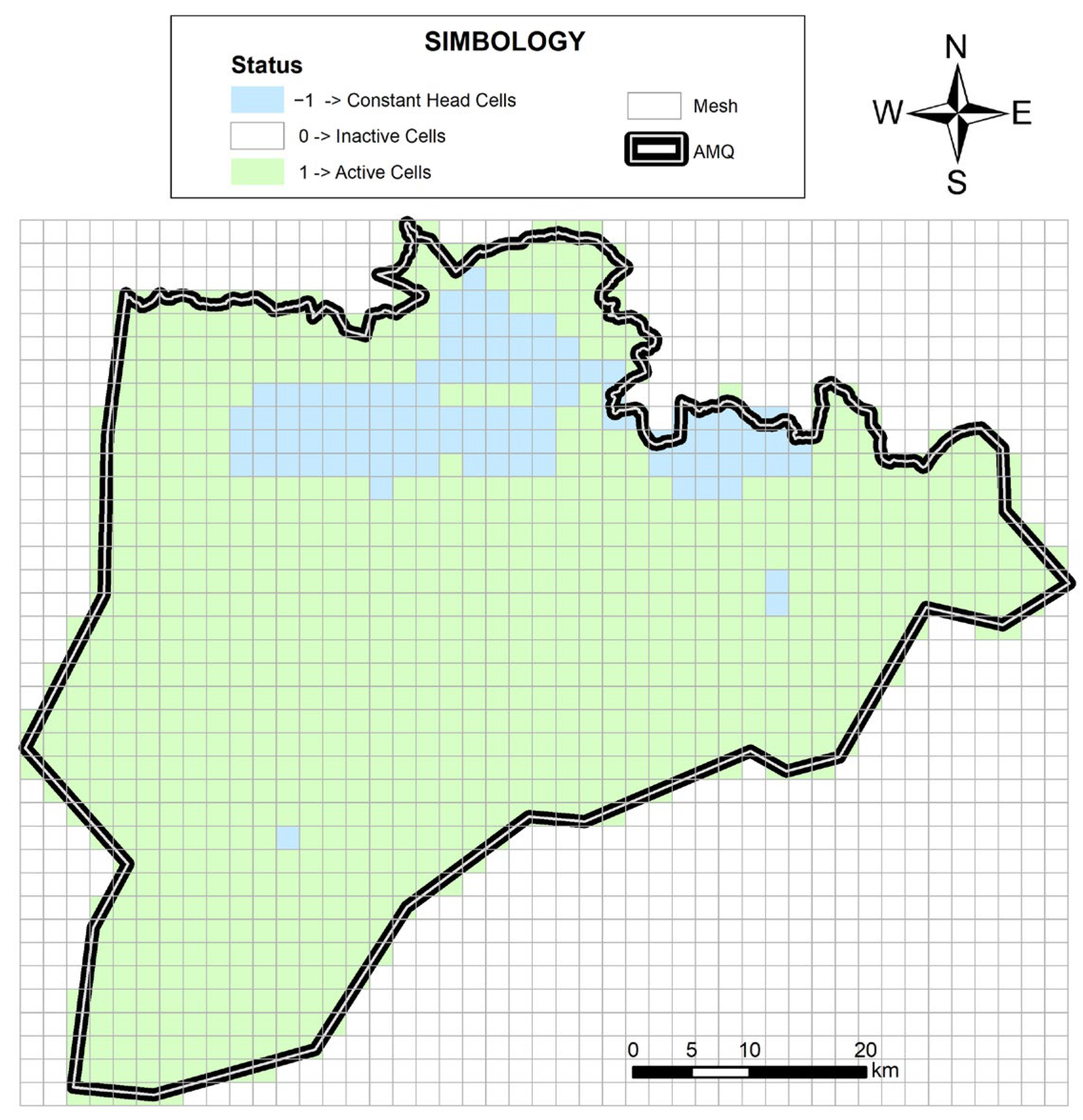
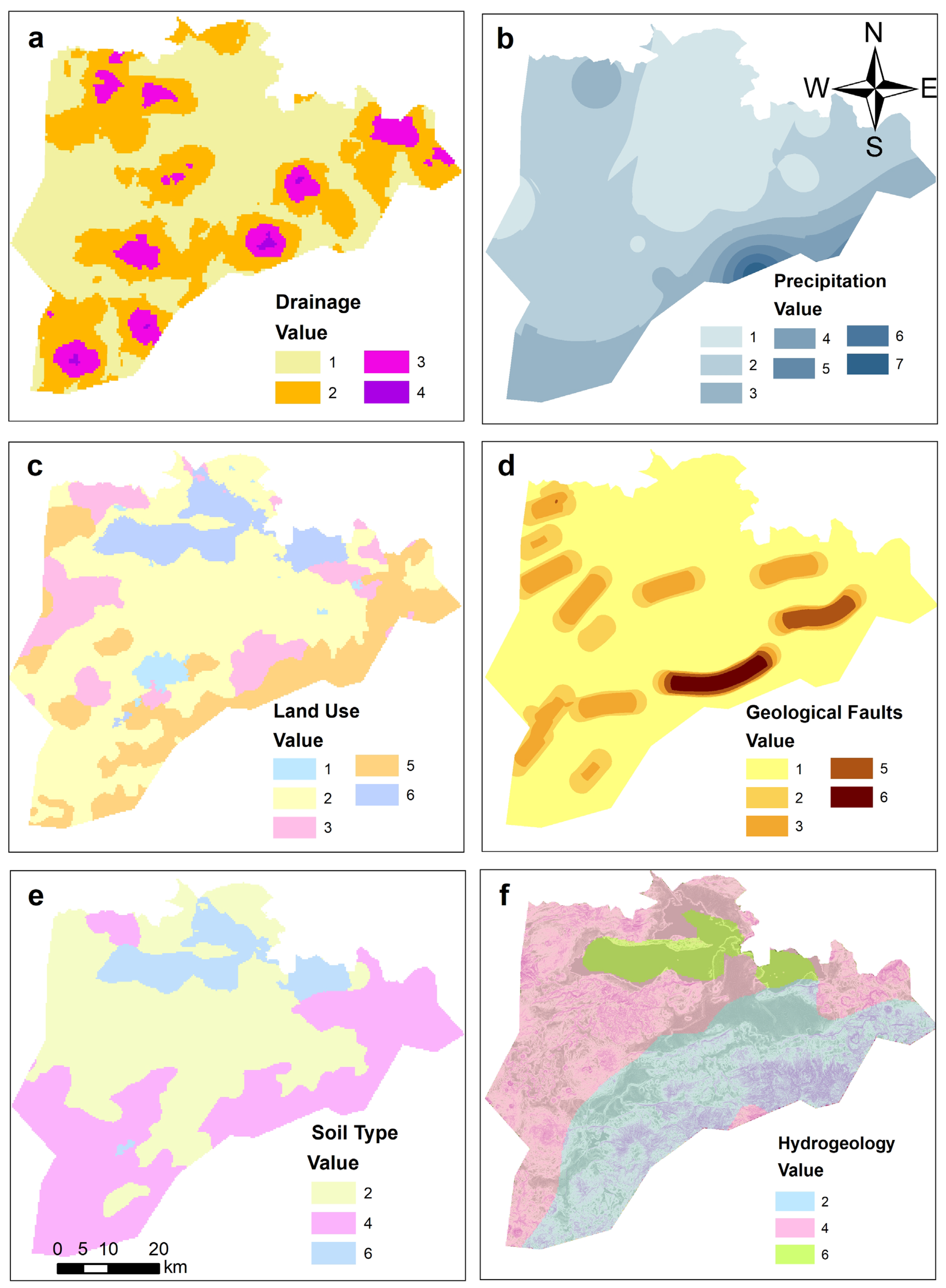

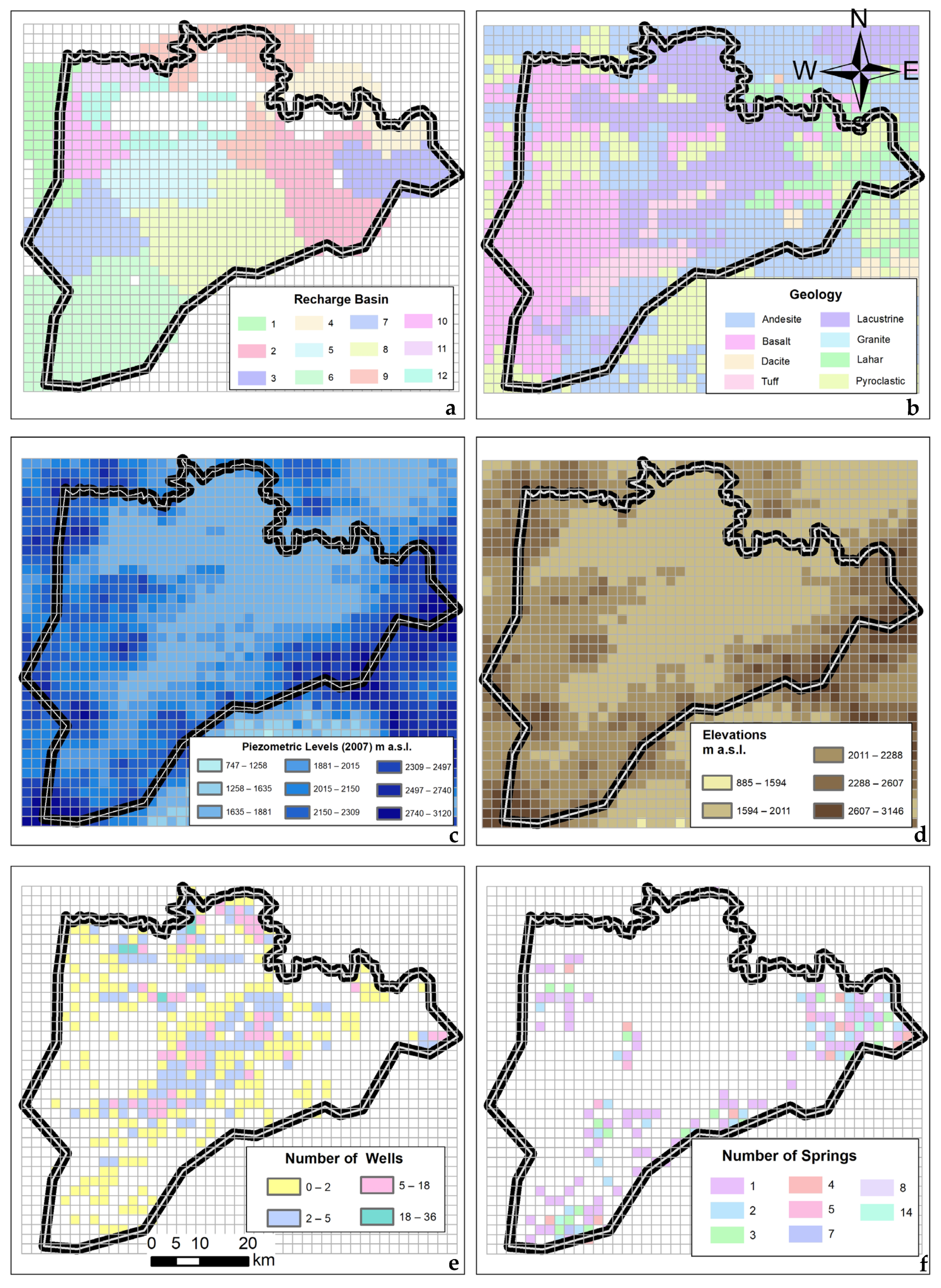

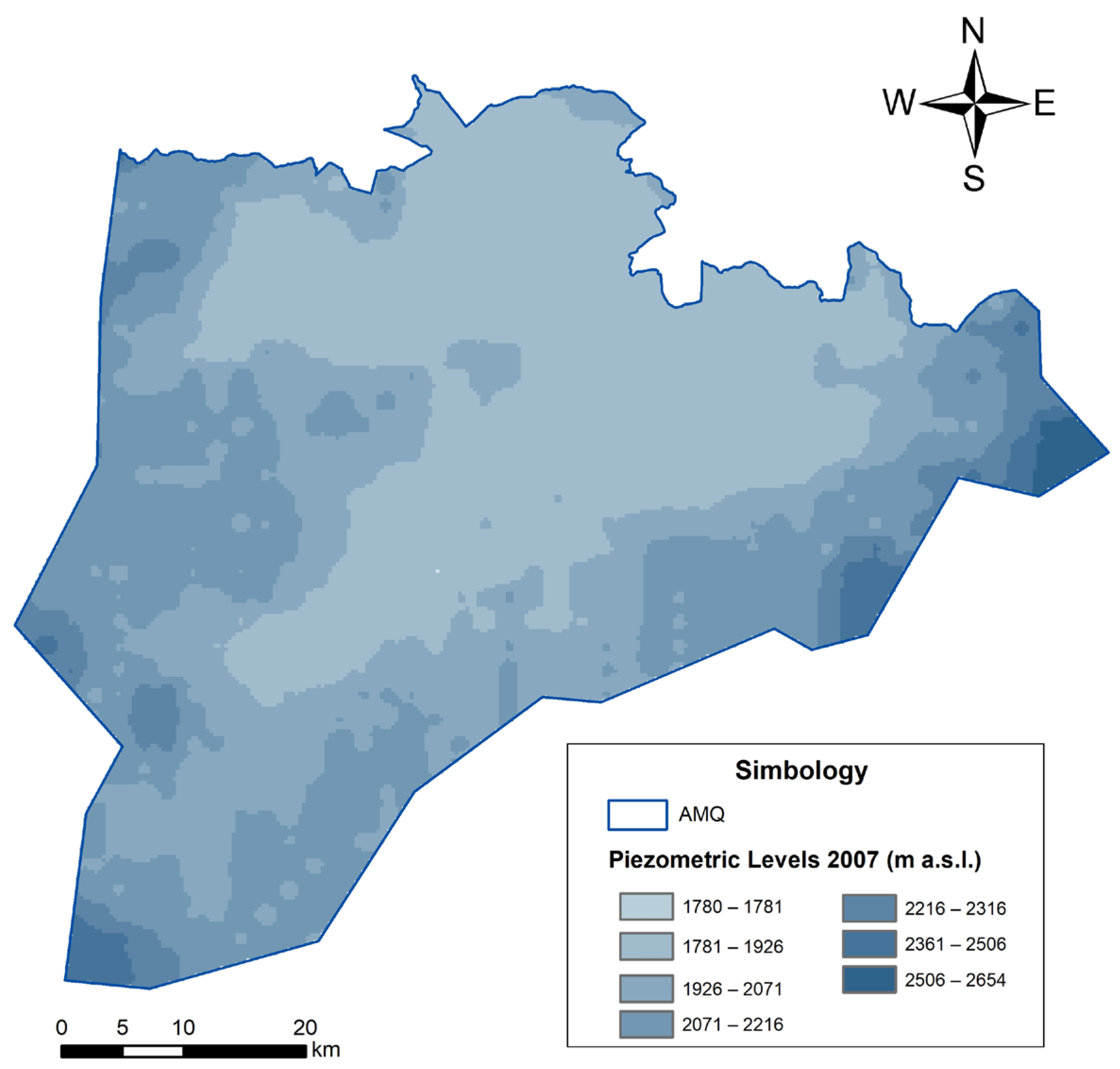
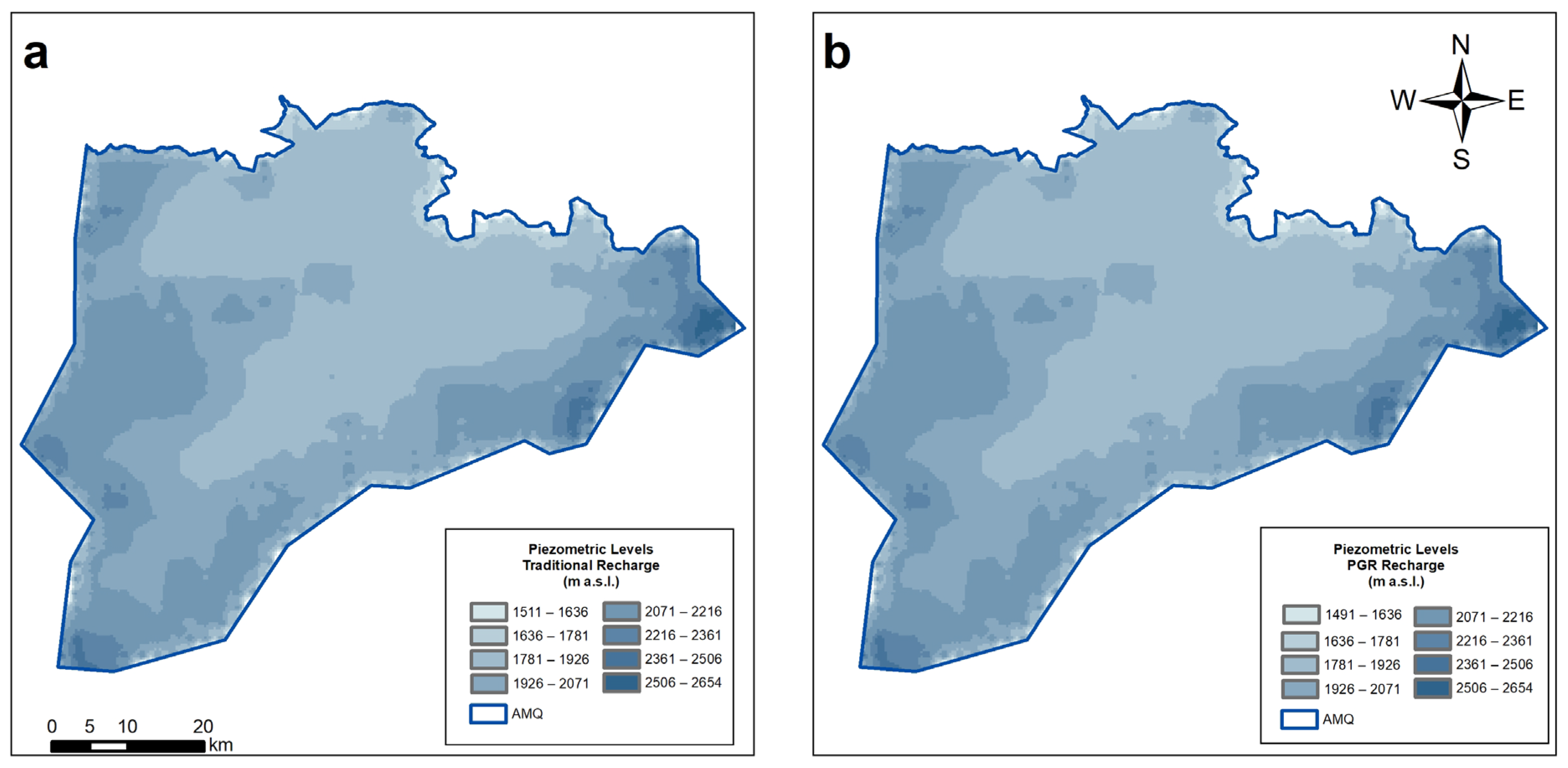
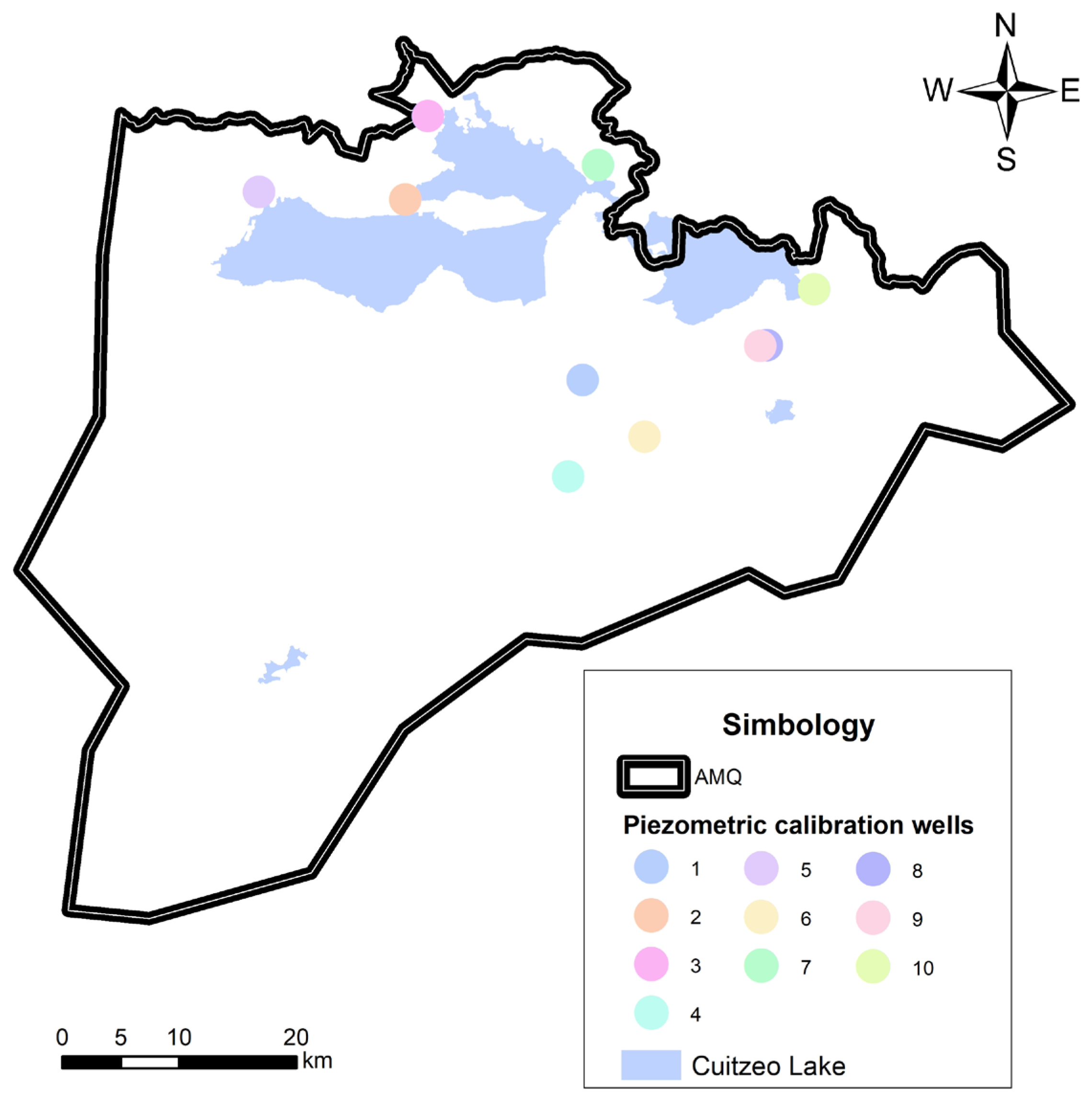


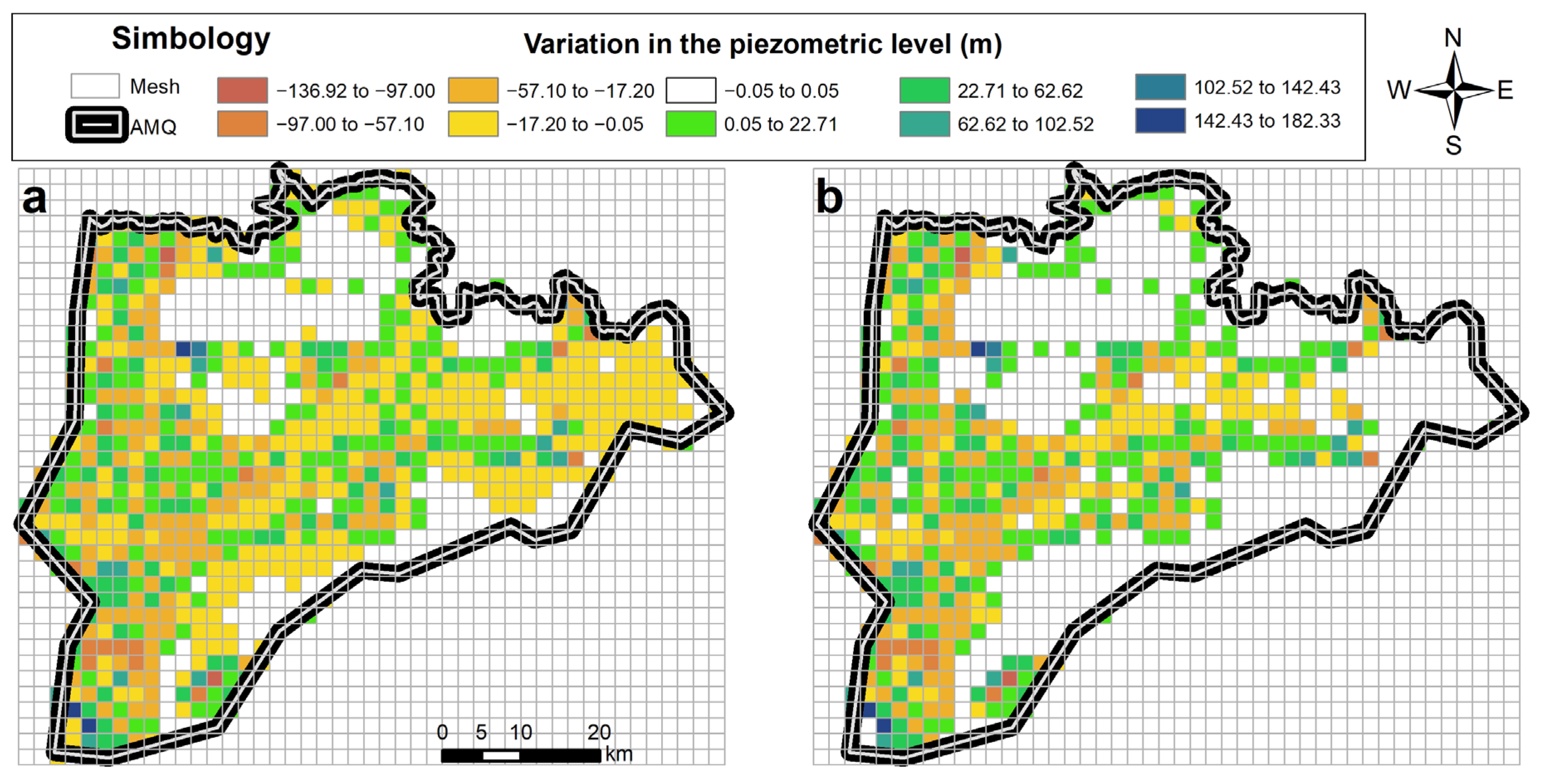
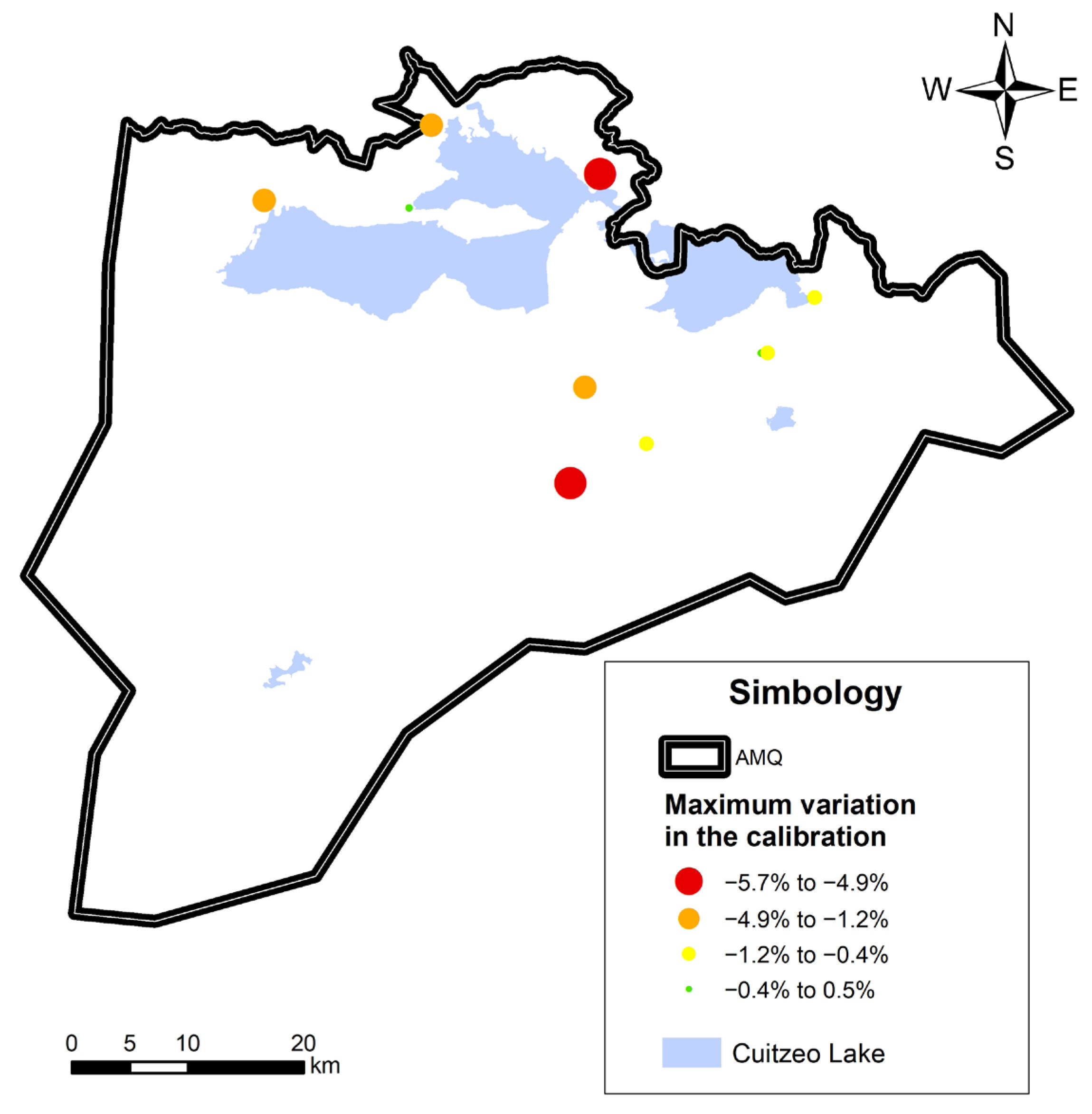
| Inputs | ML/Year | Outputs | ML/Year |
|---|---|---|---|
| Vertical Recharge | 169,672 | Pumping | 232,310 |
| Induced Recharge | 38,500 | Springs | 58,780 |
| Lateral Entrance | 88,000 | Evapotranspiration | 64,200 |
| Total | 296,172 | Total | 355,290 |
| Parameter | Characteristic | Reclassification Value |
|---|---|---|
| Hydrogeology | Low–Medium Permeability | 2 |
| Medium–High Permeability | 4 | |
| High Permeability | 6 | |
| Fault Density | Very Low | 1 |
| Low | 2 | |
| Medium | 3 | |
| High | 5 | |
| Very High | 6 | |
| Soil Type | Fine | 2 |
| Medium | 4 | |
| Alluvial | 6 | |
| Soil Use | Agricultural | 2 |
| Naked | 3 | |
| Urban | 1 | |
| Forest | 5 | |
| Water Body | 6 | |
| Scrub | 3 | |
| Pasture | 3 | |
| Drainage Density | Very Low | 1 |
| Low | 2 | |
| Medium | 3 | |
| Moderate High | 4 | |
| Slope | Smooth (<2%) | 7 |
| Mild (<6%) | 6 | |
| Inclined (<10%) | 5 | |
| Moderate to Very Steep (>10%) | 4 | |
| Precipitation | Very Low (654–752 mm) | 1 |
| Low (752–849 mm) | 2 | |
| Medium (849–946 mm) | 3 | |
| Moderate High (946–1044 mm) | 4 | |
| High (1044–1141 mm) | 5 | |
| Very High (1141–1238 mm) | 6 | |
| Too High (1238–1336 mm) | 7 |
| Geology | Kmin (m/day) | Smax (Dimensionless Parameter) |
|---|---|---|
| Andesite | 0.001 | 0.05 |
| Basalt | 10 | 0.05 |
| Dacite | 0.001 | 0.005 |
| Granite | 3.3 | 0.18 |
| Lacustine | 3.3 | 0.06 |
| Lahar | 0.0001 | 0.005 |
| Limestone | 0.001 | 0.06 |
| Pyroclastic | 0.0001 | 0.005 |
| Rhyolite | 0.00001 | 0.005 |
| Sandstone–Medium | 3.3 | 0.15 |
| Tuff | 0.001 | 0.05 |
| Piezometric Levels | |||||||||
|---|---|---|---|---|---|---|---|---|---|
| Observed | Traditional Modeling | Variation in PGR vs. Traditional | |||||||
| Well | 2008 | 2017 | 2022 | 2008 | 2017 | 2022 | 2008 | 2017 | 2022 |
| 1 | 1836.00 | 1833.33 | 1810.50 | 1829.791 | 1830.234 | 1830.950 | −0.002 | 0.996 | 0.961 |
| 2 | 1832.00 | 1828.19 | 1826.65 | 1822.693 | 1818.449 | 1817.928 | 0.003 | 0.115 | 0.067 |
| 3 | N/D | 1810.40 | 1797.40 | 1821.254 | 1820.944 | 1820.488 | 0.001 | 1.827 | 1.524 |
| 4 | 1867.00 | 1817.45 | 1800.13 | 1850.948 | 1882.355 | 1886.643 | 0.001 | 0.855 | 0.852 |
| 5 | 1851.00 | 1836.04 | 1829.31 | 1850.479 | 1858.26 | 1861.753 | −0.001 | 0.182 | 0.163 |
| 6 | 1856.94 | 1832.60 | 1838.63 | 1857.079 | 1851.665 | 1851.123 | 0.001 | 0.460 | 0.471 |
| 7 | 1838.89 | 1823.23 | 1820.44 | 1827.840 | 1826.720 | 1826.295 | 0.002 | 0.138 | 0.154 |
| 8 | 1847.00 | 1814.34 | 1814.75 | 1821.027 | 1822.072 | 1822.530 | −0.007 | 0.215 | 0.226 |
| 9 | N/D | 1826.50 | 1828.30 | 1821.198 | 1825.346 | 1825.665 | −0.002 | 1.177 | 0.755 |
| 10 | 1847.94 | 1836.34 | 1837.00 | 1848.213 | 1850.770 | 1851.927 | 0.000 | 0.011 | 0.012 |
| Well | ||||||||||
|---|---|---|---|---|---|---|---|---|---|---|
| 1 | 2 | 3 | 4 | 5 | 6 | 7 | 8 | 9 | 10 | |
| Traditional Recharge | ||||||||||
| 2008 | 0.3% | 0.5% | 0.9% | 0.0% | 0.0% | 0.6% | 1.4% | 0.0% | ||
| 2017 | 0.2% | 0.5% | −0.6% | −3.6% | −1.2% | −1.0% | −5.3% | −0.4% | 0.1% | −0.8% |
| 2022 | −1.1% | 0.5% | −1.3% | −4.8% | −1.8% | −0.7% | −5.8% | −0.4% | 0.1% | −0.8% |
| PGR Recharge | ||||||||||
| 2008 | 0.3% | 0.5% | 0.9% | 0.0% | 0.0% | −1.1% | 1.4% | 0.0% | ||
| 2017 | 0.1% | 0.5% | −0.7% | −3.6% | −1.2% | −1.1% | −5.3% | −0.4% | 0.0% | −0.8% |
| 2022 | −1.2% | 0.5% | −1.4% | −4.9% | −1.8% | −0.7% | −5.7% | −0.4% | 0.1% | −0.8% |
Disclaimer/Publisher’s Note: The statements, opinions and data contained in all publications are solely those of the individual author(s) and contributor(s) and not of MDPI and/or the editor(s). MDPI and/or the editor(s) disclaim responsibility for any injury to people or property resulting from any ideas, methods, instructions or products referred to in the content. |
© 2024 by the authors. Licensee MDPI, Basel, Switzerland. This article is an open access article distributed under the terms and conditions of the Creative Commons Attribution (CC BY) license (https://creativecommons.org/licenses/by/4.0/).
Share and Cite
Navarro-Farfán, M.d.M.; García-Romero, L.; Martínez-Cinco, M.A.; Hernández-Hernández, M.A.; Sánchez-Quispe, S.T. Comparison between MODFLOW Groundwater Modeling with Traditional and Distributed Recharge. Hydrology 2024, 11, 9. https://doi.org/10.3390/hydrology11010009
Navarro-Farfán MdM, García-Romero L, Martínez-Cinco MA, Hernández-Hernández MA, Sánchez-Quispe ST. Comparison between MODFLOW Groundwater Modeling with Traditional and Distributed Recharge. Hydrology. 2024; 11(1):9. https://doi.org/10.3390/hydrology11010009
Chicago/Turabian StyleNavarro-Farfán, María del Mar, Liliana García-Romero, Marco Antonio Martínez-Cinco, Mario Alberto Hernández-Hernández, and Sonia Tatiana Sánchez-Quispe. 2024. "Comparison between MODFLOW Groundwater Modeling with Traditional and Distributed Recharge" Hydrology 11, no. 1: 9. https://doi.org/10.3390/hydrology11010009
APA StyleNavarro-Farfán, M. d. M., García-Romero, L., Martínez-Cinco, M. A., Hernández-Hernández, M. A., & Sánchez-Quispe, S. T. (2024). Comparison between MODFLOW Groundwater Modeling with Traditional and Distributed Recharge. Hydrology, 11(1), 9. https://doi.org/10.3390/hydrology11010009







